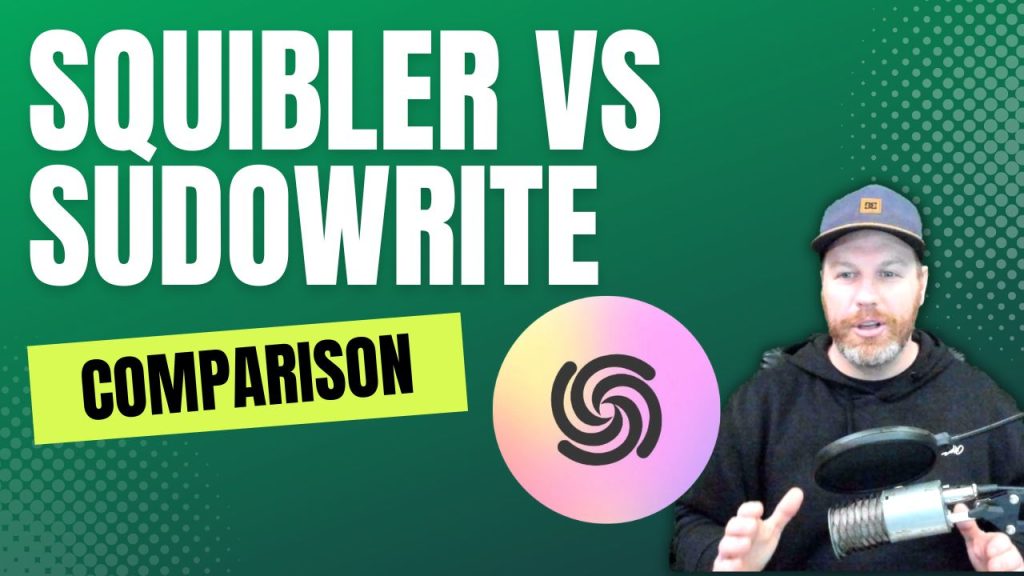
Choosing the right ai writing tool can make all the difference in your creative journey. Whether you’re crafting a book or developing a compelling story, having the right assistant by your side is essential. Today, we’re comparing two popular options: Squibler vs Sudowrite. Both are designed to enhance your writing process, but they cater to different needs and preferences.
Squibler stands out for its premium features and organizational tools, making it a favorite among authors who value structure and efficiency. On the other hand, Sudowrite shines with its AI-powered creative story generation, tailored specifically for fiction writers. Both tools are geared toward book authors and content creators seeking innovative ways to elevate their craft.
By the end of this article, you’ll have a clear understanding of which tool aligns best with your writing goals and style. Let’s dive into the details to help you make an informed decision.
| Feature | Pros | Cons |
|---|---|---|
| Project Management | Robust organization, chapter tracking | Steep learning curve |
| Collaborative Editing | Real-time collaboration | No info on simultaneous users |
| Smart Editor | AI-powered suggestions | Limited advanced formatting |
| Modular Design | Adaptable to various projects | Performance lags reported |
| Accessibility | Online access | No offline option |
The Brave New World Of Ai Writing Assistants
Writing assistants are powerful tools designed to help writers enhance their work. These assistants go beyond basic grammar checks, offering features that boost creativity and efficiency. Whether you’re drafting a first draft or refining a manuscript, they provide valuable support.
Traditional word processors like Google Docs are great for short documents but lack the advanced features needed for long-form projects. AI-driven tools step in here, offering smart suggestions, organizational aids, and even creative ideas to keep your writing flowing smoothly.
These tools can significantly improve your writing process. They suggest ideas during the first draft and help polish your work with style checks and structure improvements. For instance, they’re perfect for managing large projects like books or crafting engaging articles.
The evolution from basic word processors to smart writing tools marks a major shift in how we write. These assistants help produce high-quality content faster, making them indispensable in today’s fast-paced digital environment.
Overview of Squibler and Sudowrite
When exploring writing tools, it’s essential to understand the unique strengths of each option. Squibler and Sudowrite are two platforms designed to meet different author needs, offering distinct approaches to enhance your writing process.
Squibler stands out as a versatile option for authors, catering to fiction, nonfiction, and even scriptwriters. It’s known for its robust organizational features and efficiency, making it a top choice for those who value structure and productivity. Whether you’re drafting a novel or managing complex projects, Squibler provides the tools to keep your work organized and flowing smoothly.
On the other hand, Sudowrite is tailored specifically for fiction writers seeking AI-driven creative support. Its innovative features like the Story Engine and AI-powered prompts make it ideal for crafting compelling narratives. Sudowrite excels in helping authors overcome writer’s block and develop intricate plots, making it a favorite among novelists focused on storytelling.
Both tools cater to different audiences. Squibler appeals to a broad range of writers, while Sudowrite targets those deeply invested in creative storytelling. Understanding your writing style and goals will help you choose the best tool for your needs.
As one author noted, “The right tool can transform your writing experience.” Whether you’re managing large projects or crafting a novel, these tools offer unique benefits that can elevate your work.
In-Depth Look at Squibler Features
Discover how Squibler’s innovative features can elevate your writing experience. Whether you’re looking to boost creativity or streamline your workflow, Squibler offers a robust set of tools designed to meet your needs.
Smart Writer and AI Integration
Squibler’s Smart Writer is a game-changer for writers seeking inspiration. This AI-powered tool generates creative ideas, helping you overcome writer’s block and maintain momentum. With Smart Writer, you can produce high-quality content quickly, ensuring your writing stays engaging and focused.
Organizational Tools and Templates
Managing large projects is effortless with Squibler’s organizational features. The platform allows you to separate your work into manageable chapters, making it easy to navigate and edit. Additionally, Squibler offers a variety of templates tailored to different genres and projects, providing a solid foundation for your writing.
One of the standout features of Squibler is its regular updates, ensuring the tool stays at the forefront of writing technology. These updates refine content generation and management capabilities, keeping your writing process efficient and effective.
“The right tool can transform your writing experience.” This sentiment rings true with Squibler, as its combination of AI integration and organizational tools makes it an indispensable asset for any writer.
Sudowrite: AI Tool for Enhanced Creativity
Sudowrite is a cutting-edge AI tool designed to unlock your creative potential, especially for fiction writers. Its innovative features help you break through writer’s block and craft compelling stories. Whether you’re brainstorming ideas or refining your manuscript, Sudowrite offers a suite of tools to elevate your writing.
Story Engine and Prompt Innovation
Sudowrite’s Story Engine is a standout feature that helps you generate creative ideas and maintain narrative flow. By using prompts, you can guide the AI to produce content that aligns with your vision. This tool is particularly useful for developing intricate plots and characters, ensuring your story stays engaging and coherent.
For example, the Story Engine can assist you in creating a novella in just a weekend, as demonstrated by one author who crafted “The Electric Sea” with Sudowrite’s help. This tool not only speeds up your writing process but also enhances the quality of your work.
Advanced Revision and Brainstorming Features
Beyond idea generation, Sudowrite excels in revising and refining your work. Its advanced features allow you to rephrase sentences, expand descriptions, and even rewrite entire sections to improve clarity and impact. These tools make the editing process more efficient, helping you produce polished content faster.

Sudowrite’s pricing reflects its specialized offerings, with tiers starting at $19/month. Many authors find this a good value for the lot of creative support it provides. The middle tier at $29/month is particularly popular, offering the best balance of features and cost.
Overall, Sudowrite is an excellent choice for fiction writers seeking robust AI-based tools for brainstorming and revisions. Its innovative approach makes it a valuable asset for anyone looking to enhance their creative process.
squibler vs sudowrite
When it comes to choosing the perfect writing tool, understanding the differences between Squibler and Sudowrite is crucial. Both tools cater to distinct needs, making it essential to align your choice with your writing style and goals.
Side-by-Side Feature Comparison
Squibler excels in project management and organization, offering features like chapter tracking and genre-specific templates. These tools are ideal for writers who need structure and efficiency. On the other hand, Sudowrite focuses on creative story generation, with its Story Engine and AI-powered prompts designed to help fiction writers craft compelling narratives.
Pricing, Value, and Subscription Models
Squibler operates on a subscription-based model, providing access to premium features and regular updates. Sudowrite, however, uses a credit-based system, where credits are used to generate content. Both tools offer free trials, allowing you to explore their features before committing.
When evaluating the value, consider your project needs. Squibler is a great choice for managing large projects, while Sudowrite is perfect for enhancing creativity. Your budget and writing style will guide you in selecting the tool that offers the best way to advance your writing process.
- Feature Focus: Squibler for organization, Sudowrite for creativity.
- Pricing Models: Subscription (Squibler) vs. Credit-based (Sudowrite).
- Free Trials: Both offer trials to test features.
In conclusion, the choice between Squibler and Sudowrite depends on whether you prioritize project management or creative generation. Both tools are excellent in their respective domains, so consider your needs carefully to make the best decision for your writing journey.
Pros and Cons of Squibler
If you’re considering Squibler as your writing tool, it’s important to weigh its advantages and disadvantages. This balanced view will help you decide if it’s the right fit for your needs.
Strengths in Project Management
Squibler truly shines when it comes to organizing your work. Its robust project management features make it easy to handle large manuscripts. With tools that let you break your work into chapters and scenes, you can navigate and edit your manuscript effortlessly.
The app also offers collaborative editing, allowing multiple users to work on the same project. This feature is especially useful for co-authors or those working with editors. Plus, Squibler’s editor includes smart suggestions to enhance your writing quality and keep your content engaging.
Another standout feature is the modular design of the program. It adapts well to various writing styles, whether you’re drafting a novel or preparing a blog post. This flexibility makes Squibler a versatile tool for many writers.
Identified Limitations and Drawbacks
While Squibler has many strengths, it’s not without its drawbacks. Some users have reported performance issues, such as lag, which can disrupt your workflow. Additionally, the app has a higher price point compared to some alternatives, which might be a concern for budget-conscious writers.
Another limitation is the lack of advanced formatting options. While the editor is functional, it doesn’t offer the same level of customization as some other tools. This might be a drawback for writers who need precise control over their manuscript’s appearance.
Finally, Squibler is currently an online-only program, requiring an internet connection. There’s no desktop or mobile app available, which could be inconvenient for some users who prefer offline access.
In summary, Squibler is a powerful tool for writers who value strong project management and collaborative features. However, its higher cost and performance issues might make it less ideal for some. Weighing these pros and cons will help you determine if Squibler is the best choice for your writing projects.
Pros and Cons of Sudowrite
When evaluating Sudowrite, it’s essential to consider both its strengths and weaknesses to determine if it aligns with your writing goals. Sudowrite shines with its ability to streamline your writing process and improve the quality of your draft. Its advanced brainstorming capabilities are particularly useful for generating scenes that captivate your readers.
One of Sudowrite’s standout features is its focus on creative prompts, which compensates for its limited selection of built-in templates. This makes it an excellent choice for fiction writers looking to enhance their storytelling. However, some users find the interface complex, which can be overwhelming for new writers.
While Sudowrite offers innovative tools, it’s important to weigh these advantages against its potential drawbacks. The interface’s complexity and limited template options might be a hurdle for some. However, its ability to enhance your writing process and create compelling scenes makes it a valuable asset for many authors.
Suitability for Different Types of Writers
Choosing the right writing tool depends on your genre, experience, and project needs. Both Squibler and Sudowrite cater to a wide range of writers, from fiction authors to content creators, offering tailored features that enhance your writing process.
Fiction, Nonfiction, and Content Creation
Fiction writers will find Sudowrite particularly useful due to its AI-driven creative prompts and story engine, which help develop compelling narratives and characters. The tool excels in supporting character development and plot intricacies, making it ideal for crafting engaging fiction. Squibler, on the other hand, is versatile, accommodating both fiction and nonfiction projects with its organizational features and templates.
Beginners Versus Experienced Authors
Beginners benefit from Squibler’s guided features and structured approach, which help build a solid foundation. Experienced writers may prefer Sudowrite’s advanced creative tools for refining their craft. Both tools offer cost-effective solutions, with Squibler’s subscription model and Sudowrite’s credit-based system providing flexibility based on your project needs.
| Writer Type | Squibler Features | Sudowrite Features | Cost Considerations | Best For |
|---|---|---|---|---|
| Fiction Authors | Organizational tools, genre-specific templates | Story Engine, AI prompts for character development | $10/month subscription | Structured projects |
| Nonfiction Writers | Efficient content management | Advanced editing tools | Flexible credit system | Polishing manuscripts |
| Beginners | Guided writing process | Creative brainstorming tools | Affordable plans | Learning and growth |
| Experienced | Advanced editing features | AI-driven narrative support | Cost-effective for high-volume use | Refining and enhancing |

Both tools offer free trials, allowing you to explore their features. Whether you’re focused on character development or organizing large projects, these tools provide the necessary element to elevate your writing.
Pricing and Subscription Models
When selecting a writing tool, pricing and subscription models are crucial factors to consider. Both Squibler and Sudowrite offer distinct pricing structures designed to cater to different needs and budgets.
Squibler provides a subscription-based model, with a monthly plan priced at $29 and an annual option at $192 ($16/month). It also offers a free version with limited features. Sudowrite, on the other hand, operates on a credit-based system, with three pricing tiers: $19, $29, and $59 per month. Sudowrite also offers a free trial for users to explore its features.
The cost of these tools can significantly impact your writing experience. Squibler’s annual plan, for instance, includes a hardcover copy of your book, which is ideal for authors looking to publish. Sudowrite’s focus on brainstorming and creative writing makes it a great choice for fiction writers, though its higher-tier plans may be less affordable for some.
Other tools in the market offer different pricing options. For example, Novel AI charges $10-$25/month, while ChatGPT offers a free tier with paid plans starting at $20/month. These comparisons help you understand the value each tool provides based on your writing process.
| Tool | Subscription Model | Monthly Fee | Best For |
|---|---|---|---|
| Squibler | Subscription-based | $29 (monthly) $192 (annual) | Structured projects |
| Sudowrite | Credit-based | $19-$59 | Creative storytelling |
| Novel AI | Subscription-based | $10-$25 | Affordable fiction writing |
| ChatGPT | Freemium | $20-$200 | General writing assistance |
Ultimately, your choice depends on your writing needs and budget. Both Squibler and Sudowrite offer unique benefits, but considering their pricing models will help you make the best decision for your creative process.
User Experience and Interface
The user experience of a writing tool can significantly influence your productivity and creativity. Both Squibler and Sudowrite offer unique interfaces designed to enhance your writing process, but they cater to different needs.
Ease of Navigation and Workflow
Squibler is known for its intuitive interface, which makes it easy to navigate and manage large projects. The workflow is streamlined, allowing you to break your work into chapters and scenes seamlessly. This feature is particularly helpful for authors who value organization and efficiency. On the other hand, Sudowrite focuses on creative workflow, offering tools like the Story Engine to help generate ideas and maintain narrative flow.
One standout feature of Squibler is its collaborative editing option, which enables multiple users to work on the same project. This makes it ideal for co-authors or those working with editors. Sudowrite, however, excels in brainstorming and developing intricate plots, making it a favorite among fiction writers.
Performance, Speed, and Reliability
When it comes to performance, Squibler and Sudowrite have their strengths and weaknesses. Squibler’s interface is robust but has been known to lag occasionally, which can disrupt your workflow. Sudowrite, on the other hand, is praised for its smooth operation, even when handling large projects.
User feedback highlights that Sudowrite performs well under heavy writing loads, making it a reliable choice for authors with extensive projects. Squibler’s reliability is also commendable, though some users have reported minor performance issues. Overall, both tools are designed to provide a seamless writing experience, but your choice will depend on whether you prioritize organization or creativity.
In conclusion, the interface and user experience of Squibler and Sudowrite are tailored to different writing styles. Squibler’s organizational features make it ideal for structured projects, while Sudowrite’s creative tools are perfect for fiction writers. By understanding which aspects matter most to you, you can choose the tool that best optimizes your daily writing routine.
Conclusion
In the world of writing tools, both Squibler and Sudowrite stand out as powerful solutions for different needs. Squibler excels in project management and organization, making it ideal for writers who value structure and efficiency. Its robust features help manage large manuscripts with ease, though it comes at a higher price point. On the other hand, Sudowrite shines with its AI-driven creative generation, perfect for fiction writers looking to enhance their storytelling and overcome writer’s block.
When considering your writing style and budget, Squibler’s subscription model offers steady access to premium features, while Sudowrite’s credit-based system provides flexibility. If you prioritize creative generation and work within a specific genre, Sudowrite might be your best choice. For those needing strong organizational tools, Squibler is the way to go. Both tools offer free trials, allowing you to explore their features before committing.
Ultimately, the choice depends on whether you need structured project management or creative generation. By focusing on your unique needs and budget, you can select the tool that best enhances your writing process and helps you produce high-quality content efficiently. If you liked this article be sure to check out our top 9 Ai text generators.


